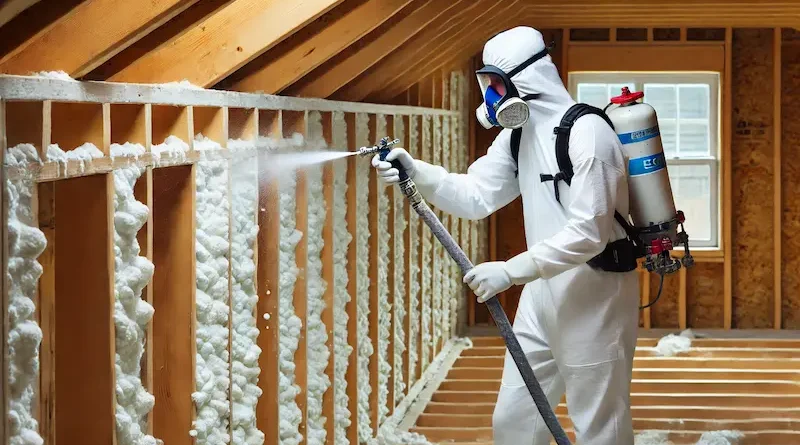Spray Foam Unlimited
Introduction
Spray foam insulation has become a popular choice for homeowners, builders, and contractors alike. It offers unique advantages over traditional insulation materials, creating a more energy-efficient and comfortable environment for buildings of all kinds. But what exactly is spray foam, and why are so many people turning to it?
This guide will provide a comprehensive look at spray foam, discussing its types, benefits, potential applications, and how to choose the best option for your needs. If you’re considering this for your home or business, read on to find out everything you need to know.
What is Spray Foam Insulation?
Spray foam insulation is a type of insulation applied as a liquid, which then expands into a thick foam. Unlike other types of insulation, like fiberglass or cellulose, spray foam has the unique ability to seal gaps, cracks, and even the tiniest crevices. Once it’s applied, it expands and hardens, providing an airtight seal that traditional insulation often can’t achieve.
There are two primary types of spray foam insulation:
- Open-Cell Spray Foam: This type is less dense and has a spongy feel. It’s more affordable and often used in walls and ceilings.
- Closed-Cell Spray Foam: Known for its density and rigidity, closed-cell foam offers better insulation and moisture resistance but tends to be more expensive.
Both types have their unique properties and can be used depending on your specific needs.
Key Benefits of Spray Foam Insulation
1. Energy Efficiency
One of the main reasons people opt for spray foam insulation is its effectiveness in reducing energy costs. When applied, spray foam forms a seamless barrier that prevents air from leaking out or sneaking in, keeping your home’s temperature stable. This can help reduce the workload on heating and cooling systems, leading to lower utility bills.
2. Air and Moisture Barrier
Spray foam is excellent at keeping moisture out, which is a huge plus in areas with high humidity or frequent rain. Moisture can cause mold growth, leading to health issues and costly repairs. By creating a strong barrier, spray foam helps to protect against these issues.
3. Improved Indoor Air Quality
Traditional insulation can trap allergens, dust, and other airborne particles. Spray foam’s airtight seal helps reduce the entry of pollutants, potentially improving indoor air quality. It’s an especially appealing option for people with allergies or respiratory concerns.
4. Longevity and Durability
Once spray foam insulation is applied, it doesn’t settle or degrade as quickly as other materials might. Its solid structure makes it long-lasting, meaning you won’t have to worry about replacing it for many years. This durability often offsets the initial cost, making it a wise investment.
5. Soundproofing Qualities
Because of its density, spray foam is also a great sound insulator. Many homeowners use it to reduce noise from outside, making their homes quieter and more peaceful. This can be especially beneficial if you live near a busy road or in a noisy neighborhood.
Common Applications for Spray Foam Insulation
Spray foam isn’t just for residential walls and attics. Here’s a look at where it can be applied:
- Residential Homes: Walls, ceilings, and attics are common areas where spray foam is used to insulate and create an energy-efficient environment.
- Commercial Buildings: Offices, warehouses, and retail spaces can benefit from spray foam insulation, helping to control temperature and reduce noise.
- Metal Buildings: Metal structures often experience more temperature fluctuation, and spray foam helps stabilize this while preventing condensation.
- Basements and Crawl Spaces: These areas are prone to moisture issues, making spray foam an excellent choice for sealing and insulating.
- Roofs: Spray foam can even be applied to roofs, protecting against leaks and providing an additional layer of insulation.
How Spray Foam Insulation Works
Understanding how spray foam insulation works can give insight into its effectiveness. When sprayed, the liquid expands to fill any gaps, cracks, or spaces. This expansion allows it to conform to any shape or surface, forming an unbroken layer. Unlike traditional insulation, spray foam doesn’t leave room for air or moisture to get through.
Choosing the Right Type of Spray Foam for Your Needs
While both open-cell and closed-cell foam offer excellent insulation, each has specific qualities:
- Open-Cell Spray Foam: Ideal for indoor use, this type of foam is often used in walls and ceilings. It’s breathable, allowing water vapor to pass through, which can help in certain climate conditions. Plus, it’s usually more budget-friendly.
- Closed-Cell Spray Foam: This type has a denser structure, making it a better choice for areas exposed to moisture, like basements and crawl spaces. It also has a higher R-value, meaning it provides better insulation.
Installation Process: What to Expect
The process of installing spray foam insulation typically involves the following steps:
- Preparation: The area where the foam will be applied is cleared of dust, dirt, and other debris.
- Spraying: A professional uses specialized equipment to spray the foam, which then expands to fill the space.
- Curing: After application, the foam needs time to harden and set. This usually takes a few hours.
- Trimming: Once the foam has set, any excess is trimmed away to create a smooth, even surface.
It’s crucial to hire a professional for spray foam installation, as the process requires specialized knowledge and equipment.
Safety Considerations with Spray Foam Insulation
While spray foam offers numerous benefits, safety is an important factor to consider. Here are a few tips:
- Proper Ventilation: The chemicals used in spray foam release fumes during installation, so good ventilation is essential. It’s best to vacate the area during and shortly after installation.
- Protective Gear: Professionals should always wear protective gear to avoid direct skin and eye contact with the foam.
- Fire Safety: Spray foam is flammable, so it’s important to follow fire safety guidelines and, if necessary, install a thermal barrier.
Environmental Impact of Spray Foam Insulation
Many people are concerned about the environmental footprint of spray foam. While it’s made from chemicals, the energy savings it provides can offset the initial environmental cost over time. Additionally, new eco-friendly formulas are becoming available, which offer the same benefits without as many environmental drawbacks.
Cost of Spray Foam Insulation
The cost of spray foam insulation varies depending on several factors, including the type of foam, the area being insulated, and the installation complexity. While it’s generally more expensive than traditional insulation options, the long-term savings in energy bills often make it worthwhile. Many homeowners find that the initial investment is recovered within a few years due to reduced energy costs.
Is Spray Foam Right for You?
Spray foam insulation offers substantial benefits, but it isn’t the right fit for every situation. Here are a few factors to consider:
- Budget: While spray foam saves money over time, the upfront cost can be high.
- Building Type: Spray foam works well in most structures, but some older buildings may require additional preparation.
- Climate: In areas with extreme temperatures, spray foam’s insulating power can be especially beneficial.
Tips for Choosing a Spray Foam Installer
A professional installation is essential for effective insulation. When choosing a contractor, look for the following:
- Experience: An experienced installer will understand how to handle the product safely and effectively.
- References and Reviews: Reviews from past clients can give insight into the contractor’s reliability and skill.
- Licensing and Insurance: Ensure the contractor is licensed and insured to protect yourself and your property.
Conclusion
Spray foam insulation is a powerful tool for creating an energy-efficient, comfortable living or working environment. By sealing gaps and providing a solid layer of insulation, it offers advantages that traditional insulation methods can’t match. Whether you’re looking to improve your home’s energy efficiency, protect against moisture, or simply reduce noise, spray foam could be the perfect solution.
As with any significant investment, it’s essential to weigh the benefits and costs and consult with professionals to ensure you’re making the right choice. With careful consideration and expert installation, spray foam can provide lasting benefits that enhance the quality and value of your property.
Visit the rest of the site Digital Magazine Time for more interesting and useful articles. Thank you!

